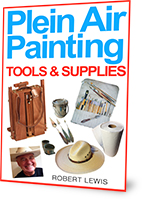The landscape is beautiful and inspiring and you want to capture that beauty. You see the landscape before you, you see the beauty, you set up your easel, you pick up your brush and…where to begin? What all made sense one minute becomes a confusing collection of objects the next minute and what was so clear suddenly becomes confusing. How to start? What to actually paint? What to focus on? What to leave in? What to leave out?
The landscape makes sense to us as casual viewers. The brain knows what to do with the information and all is well. We see the landscape before us, we see the beauty,
and we are happy, even inspired. But try to put all of that down on canvas and you soon discover that it isn’t as simple as that, and what was wonderful and simple a moment before becomes a tangled mess of light, texture, and line.
To avoid this really unsettling experience, it is best to begin your plein air career by keeping a sketchbook and practicing, practicing, practicing. What are you practicing? What is the goal? It is not to become good at drawing because we are not talking about drawing here. We are talking about sketching. And the essence of sketching is to grab, quickly, the essence of the thing before us.
Sketching the landscape trains your mind and eye to grasp the structure of the scene before you. Practicing this simple thing will, over time, allow you to quickly understand the landscape, not just appreciate it. Being able to quickly “grasp” what is before you will allow you to do what you want, “capture” that beauty you see. This is the first step, to be able to understand what you are looking at.
Practice making sense of the landscape by sketching every day for at least a few minutes. The simplest way is to keep a sketchbook with you at all times. Keep it in your car. Use a spiral bound, inexpensive sketchbook so that you don’t become too attached to its value. Use a carpenter’s pencil so that you don’t become obsessed with the details of the landscape. When you are done sketching the scene, close the sketchbook and do not look at the sketch again.
Let’s make this really clear. This is sketching, not drawing. Sketching. NOT drawing. You are not creating drawings that you might present in a show as art. This is the practice of the sketch. In a drawing, much time is given to details, the character of line. In this practice of sketching, you sketch quickly, as quickly as possible, grabbing the composition of the landscape and noting the salient features and abandoning all detail. Sketching should be practice for at least a month on a daily basis before attempting painting.*
*Note from the author: In my case, I sketched for two years before I allowed myself to paint anything on canvas.







